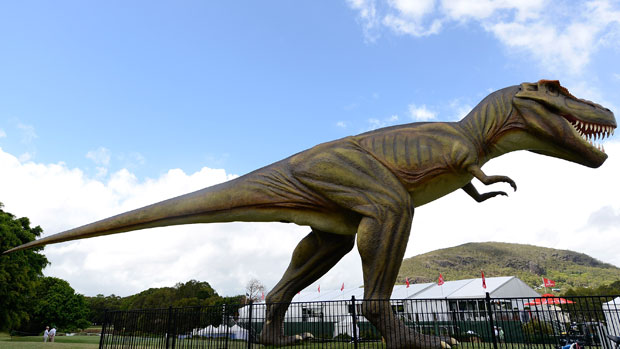A terror of tyrannosaurs: did dinosaurs hunt in packs?
Discovery of fossilised footprints in Canada suggest tyrannosaurs worked together to stalk prey

Palaeontologists claim to have found evidence that supports the much-debated theory that tyrannosaurs hunted prey in packs known as 'terrors'.
According to The Guardian, researchers in Cananda uncovered a group of fossilised tyrannosaurus footprints that were "apparently left by three animals going the same way at the same time" almost 70 million years ago.
"We hit the jackpot," said study co-author Richard McCrea. "A single footprint is interesting, but a trackway gives you way more. This is about the strongest evidence you can get that these were gregarious animals. The only stronger evidence I can think of is going back in a time machine to watch them."
The Week
Escape your echo chamber. Get the facts behind the news, plus analysis from multiple perspectives.

Sign up for The Week's Free Newsletters
From our morning news briefing to a weekly Good News Newsletter, get the best of The Week delivered directly to your inbox.
From our morning news briefing to a weekly Good News Newsletter, get the best of The Week delivered directly to your inbox.
The trackways, which had been buried under layers of volcanic ash, "were so well-preserved that even the contours of the animals' skin were visible". Scientists estimated by the size of the footprints that the dinosaurs were in "their late 20s or early 30s – a venerable age for tyrannosaurs".
The study concluded that “all three trackways show animals bearing southeast within an 8.5 meter-wide corridor” with the fossils' proximity indicating that the predators “stuck together as a pack to increase their chances of bringing down prey and individually surviving”, quotes the Daily Mail.
Even though previous discoveries suggested the animals were solitary hunters, McCrea claimed that the concurrent discovery of footprints from other dinosaur species heading in separate directions throughout the region supports the tyrannosaurus 'terror' theory.
"If all the other animals are moving in different directions, it means there is no geographical constraint, and it strengthens the case," said McCrea.
A free daily email with the biggest news stories of the day – and the best features from TheWeek.com
"You start wondering what it would have been like to have been there when the tracks were made", he continued. "The word is terror. I wouldn't want to meet them in a dark alley at night."
-
 Political cartoons for January 4
Political cartoons for January 4Cartoons Sunday's political cartoons include a resolution to learn a new language, and new names in Hades and on battleships
-
 The ultimate films of 2025 by genre
The ultimate films of 2025 by genreThe Week Recommends From comedies to thrillers, documentaries to animations, 2025 featured some unforgettable film moments
-
 Political cartoons for January 3
Political cartoons for January 3Cartoons Saturday's political cartoons include citizen journalists, self-reflective AI, and Donald Trump's transparency
-
 'Angel' visits woman before lottery win
'Angel' visits woman before lottery winTall Tales And other stories from the stranger side of life
-
 Doomsday group offers 'epic' survival opportunity
Doomsday group offers 'epic' survival opportunityTall Tales And other stories from the stranger side of life
-
 What we know about the Titan sub’s likely implosion
What we know about the Titan sub’s likely implosionfeature Experts say the five passengers would have died ‘instantaneously’ following ‘catastrophic’ loss of pressure
-
 What happened to the missing Titanic sub?
What happened to the missing Titanic sub?Today's Big Question Oxygen supplies running out after vessel lost contact during ‘daredevil’ trip
-
 Man arrested after shooting himself in the leg
Man arrested after shooting himself in the legfeature And other stories from the stranger side of life
-
 Scientists have watched the end of the world
Scientists have watched the end of the worldfeature And other stories from the stranger side of life
-
 Canada’s troubled relationship with its indigenous population
Canada’s troubled relationship with its indigenous populationfeature State grappling with reparations amid accusations of genocides against First Nations people
-
 Woman passes driving test at 960th attempt
Woman passes driving test at 960th attemptfeature And other stories from the stranger side of life